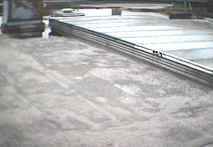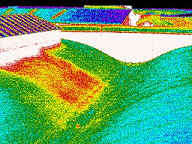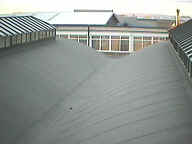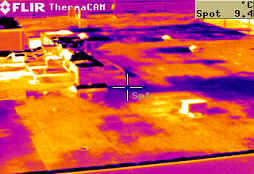| Infrared Thermographic surveys are becoming a
necessity for all of us due to Part L. So what are they? |
| An "IRT" survey is essentially taking
pictures of your building. It is that simple. The only difference being,
the cameras see energy instead of light. Time on site is minimal with
little disruption. |
| Flat roofing is a good application for IRT, it
can show you exactly where insulation is missing, wet, or help find areas
with trapped water. There is no need to cut core samples into a perfectly
good roof and then risk applying a felt patch when thermography can take
an image of the roof. The biggest benefit of this type of survey is that
you learn about the entire roof - not just where you happen to take the
core samples. |
| What infrared can't tell you of course is what
the roof is made of. Ideally you want to use infrared in-conjunction with
core sampling to learn as much as possible about the roof. |
|

Wet insulation on flat roof - red areas. |

Normal picture of thermal image |
|

Barrel vaulted roof. Hot spot! |

Photo of thermal image to the left. |
| The IR equipment is now as portable and as easy
to use as a camcorder. The difficulty lies not in taking the images, but
in understanding them. For example: plant can generate lots of heat, which
will look exactly like wet insulation on a flat roof. Therefore the
thermographer must appreciate the building as a whole. |
| It should be noted that infrared is not perfect. There are
many pitfalls awaiting the inexperienced! |
|

A badly ponding roof. |
Infrared images on their own can be very miss leading.
Insist on normal photographs to back up the thermal images. A simple
puddle on a roof reflecting the sky can lead to some obscure
interpretations.
|
| It is important that the IRT consultant is a building
specialist, is using the latest equipment and is properly trained in the
theory of infrared and thermodynamics. Mistakes can be expensive. |
| Unfortunately, the weather plays a big part in thermal
surveys. Too wet, too warm or even too windy and external surveys should
be avoided. |
| As such, there are certain conditions and times which should
be avoided for a thermal survey to yield useful results. The UK
Thermographic Association has issued guidelines to its members to try and
create uniformity within the industry. Basic principals apply: |
- A temperature difference of 10 degrees between the internal and
external is desirable as a minimum. The greater this difference is the
better.
- Wind speed should be less than 10 m/s.
- The roof surface should be dry.
- Surveys should be carried out in the evening / night-time, depending
on temperature.
|
| To understand the reasons for these rules you
must first understand what the thermal camera is detecting and also think
about the way heat will transfer from the building. |
| As we mentioned at the beginning of this
article the camera is only seeing energy - not sunlight. So why carry out
the survey at night? Although the camera can't see light, it can see the
effects of sunlight. So if the sun has heated up half of you roof or has
been reflected onto your roof, the camera will pick it up. Therefore a
thermal surveyor must allow the building to radiate it's own energy. By
letting the sun go down and waiting two hours the ambient temperature will
also have dropped outside - making the difference we mentioned above that
bit bigger. |
| Today's cameras allocate a colour to a
temperature. For instance red is generally hot and blue is usually cold.
The colours in between are then divided over the temperature span. (The
span is adjustable on the latest cameras). The bigger the temperature
difference the easier it is to detect. Saturated insulation may only be
1-2 degrees different from dry insulation. If the temperature difference
is large and the camera set up for the conditions, then wet insulation
will clearly show up as a totally different colour. Orange for wet, green
for dry for example. A small temperature difference, in the wrong
conditions and the same wet insulation may show up as one shade lighter
green against a slightly darker green good area. |
| Since the temperature differences we are
concerned with are very small it is important that the heat stays where it
is when it leaves the building. Therefore the lower the wind speed the
better. Wind has exactly the same effect on a roof as you do blowing on
your coffee - it cools it down - reducing the temperature difference we
are ideally looking for. See above! |
| Standing water or ballast on a roof makes a
thermal survey impossible. Water simply reflects the sky and leads to
meaningless images. Likewise, ballast holds moisture making surveys
impossible. A thermal survey on a ballasted roof will only show you damp
ballast, moss and ponding below the ballast. It gives you no indication of
the condition of the waterproofing. |
| Roofing is only one application for IRT in the
construction industry. Other applications include; |
- Delaminating render
- Cold bridge detection
- Insulation analysis
- Locating pipe-work in under-floor heating systems
|
| Part L has introduced IRT surveys for the first
time as a means of testing a building upon completion, though it remains
to be seen how many builders will take this option, or indeed how many
Local Authorities and clients will insist upon it. |
| If you would like to know more, please visit
our website at www.irtsurveys.com
or call 0870 240 3709. |